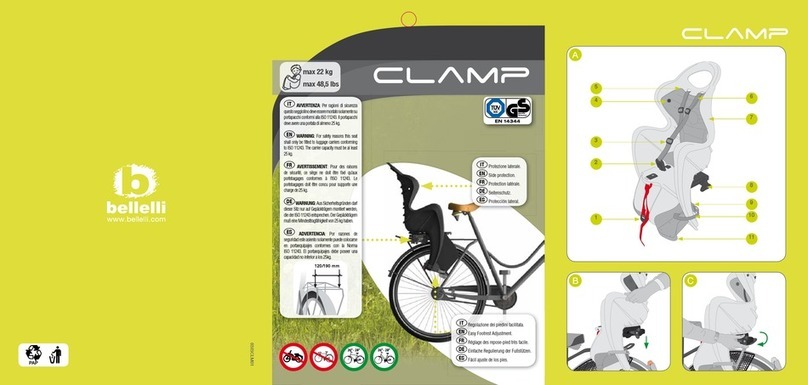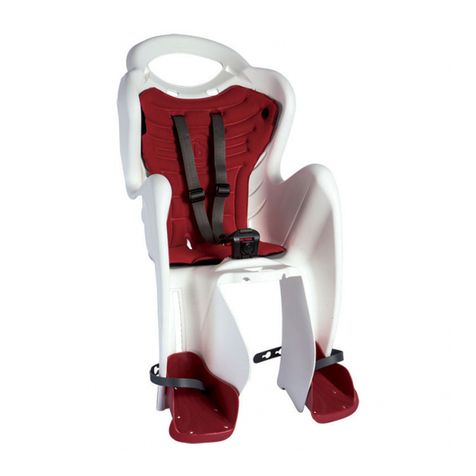
10
dei componenti adatti dipende dal telaio della bicicletta, come mostrato nelle gure C1, C2, C3,
C4, C5. Conservare le coppie di viti ed i componenti inutilizzati per una possibile installazione degli
attacchi. Non fare confusione tra le due coppie di viti.
Entrambe le coppie possono essere avvitate in quattro diverse combinazioni (Fig. B). Scegliere la
combinazione adatta per il telaio della bicicletta sulla quale va montato il supporto.
Le combinazioni illustrate nelle gure C1, C2, C3 sono equivalenti. La scelta appropriata di tali
combinazioni dipende esclusivamente dalla forma e dalle dimensioni del telaio.
NOTA: La procedura corretta di montaggio prevede che i dadi, dopo essere stati avvitati, circondino
completamente il loro letto, in altre parole che non vi siano spazi all’interno dei dadi. Se ciò non
avviene, il supporto non è correttamente avvitato. Inoltre le viti, dopo il ssaggio del supporto e
l’inserimento della copertura, devono sporgere solo limitatamente (vedi g. E).
Posizionare il supporto (7) sul telaio della bicicletta, facendo attenzione a che le due aperture, che
serviranno per il successivo inserimento della forcella di sostegno, siano rivolte verso l’alto.
ATTENZIONE: Non montare il supporto sull’asta del manubrio.
ATTENZIONE: Mettere il supporto in direzione di marcia (pulsante giallo, orientato verso il lato
anteriore della bicicletta).
Stringere leggermente i dadi in modo uniforme (Fig. D). Il supporto deve poter ruotare liberamente
attorno all’asta, per quanto compatibile con la forma del telaio. L’avvitamento denitivo avviene dopo
aver stabilito la corretta posizione del seggiolino (come descritto nel paragrafo seguente “Montaggio
del seggiolino sulla bicicletta”).
ATTENZIONE: Vericare che il supporto non intralci i cavi dei freni e la leva del cambio.
Sistema di sicurezza/antifurto
Il supporto è dotato di un sistema di sicurezza/ antifurto che può essere attivato con l’aiuto di una
chiave (5) in dotazione.
Se il sistema si trova in posizione di chiusura, non è possibile inserire o disinserire la forcella di
sostegno del seggiolino nel supporto.
Se il sistema si trova in posizione di apertura, è possibile inserire o disinserire la forcella di sostegno
del seggiolino nel supporto.
Per passare dalla posizione di apertura a quella di chiusura, inlare la chiave nella serratura (Fig. F)
e ruotarla di un quarto di giro in senso orario.
Per passare dalla posizione di chiusura a quella di apertura, inlare la chiave nella serratura (Fig. F)
e ruotarla di un quarto di giro in senso antiorario.
Montaggio della forcella di sostegno sul seggiolino
Capovolgere il seggiolino.
Posizionare la forcella di sostegno (17) sotto il seggiolino(Fig. G).
Inlare le viti (15) nel seggiolino (Fig. H).
Posizionare la piastra base di ssaggio (16) sotto il seggiolino(Fig. I).
Stringere i dadi (14), per ssare la forcella di sostegno (Fig. L).
ATTENZIONE: Controllare periodicamente la tenuta dei dadi, visto che possono allentarsi durante
l’uso.
IT IT

































